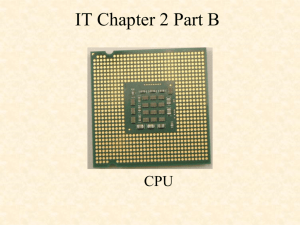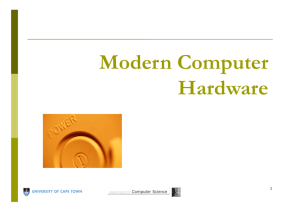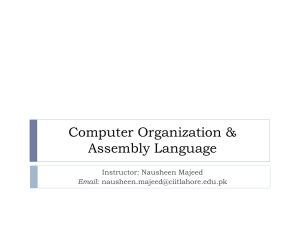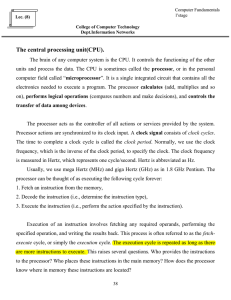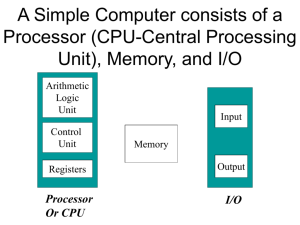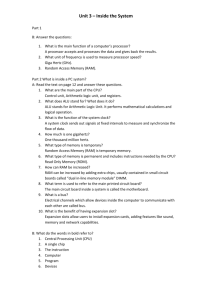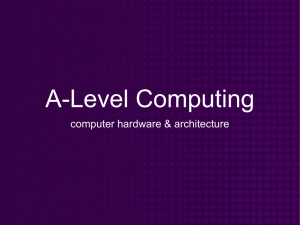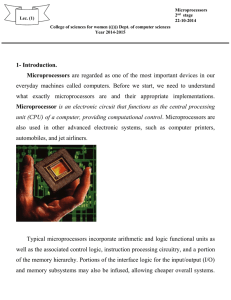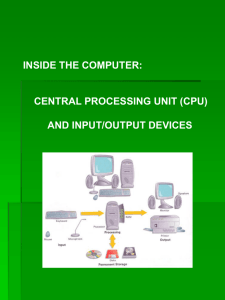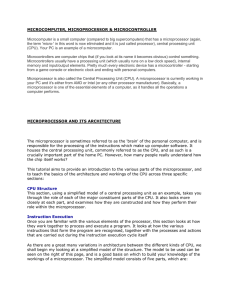Chapter Overview
advertisement
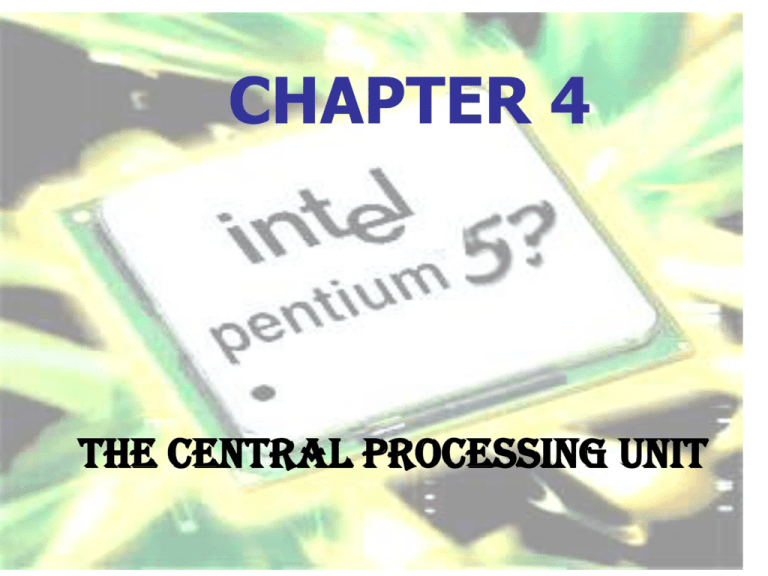
CHAPTER 4 The Central Processing Unit Chapter Overview Microprocessors Replacing and Upgrading a CPU Microprocessor Basics Components How microprocessors work PC microprocessor developments and features The External Data Bus - Information is transmitted through a computer using binary code traveling through a bus. - 8 bit data bus: allowed for the transfer of 1 byte of information at a time. - The width of the external data bus increaed to 16, and the 32 current width of conductors. (HW3) is that correct? The CPU Performs operations , decodes and executes instructions Controls computer operation Includes transistors, integrated circuits, and microprocessors Note: P4 contains 775 pins HW3: P5 Contains …… Pins Microprocessor Design Three subsystems Control unit (CU): The control unit of the CPU contains circuitry that uses electrical signals to direct the entire computer system to carry out, or execute, stored program instructions . Arithmetic logic unit (ALU): The arithmetic/logic unit (ALU) contains the electronic circuitry that executes all arithmetic and logical operations. Input/output (I/O) unit Fetches data from the outside and passes data back to the external bus Registers: Are temporary memory storage areas used during data manipulation. - Codes ( ASCII) Clock : • Timing allows the electronic devices in the computer to coordinate and execute all internal commands in the proper order. Pulse of voltage is called clock cycle. Every computer command needs at least 2 clock cycles. Clock speed • • • • The clock rate suggests how many commands can be completed in two cycles. Adding two numbers would take 4 commands (__?__ clock cycles). REGISTERS Control unit components Program counter (PC): Contains the address of an instruction to be fetched. Instruction register (IR): Contains the instruction most recently fetched. Memory address registers (MAR): Contains the address of a location in memory. Memory buffer register (MBR): Contains a word of data lo be written to memory or the word most recently read. PSW ( take home class test) 10 Memory How Microprocessors Work Adding Two Simple 2 + 2 involves more steps than a man : A = 2 Translated into binary and routed to CU and sent to X location of memory When we press + , it is translated into binary and alerts ALU to be ready for addition B= 2 is translated into binary again ALU sums A and B ALU sends the code for 4 to be stored in an address register Pressing = key is the last user action BUT the = is also translated into machine language Sum is computed PC Microprocessor Developments and Features Use the following elements to measure CPU performance: Speed : max no. of clock cycles measured in MHz Higher the speed, quicker a command will be executed Transistors: More switches means more power Registers: Larger the register size, more complicated command can be processed External data bus: if large , more and complex can be executed Address bus: determines the max amount of memory that can be addressed by CPU Internal cache It is high speed Memory built into the processor. It is the place to store the most frequently used data instead of sending it to the slow speed devices ( HDD , RAM) Virtual Memory Is the art of using Hard disk space to hold the data not immediately required by processor Possible Upgrade Scenarios 8086/8088 80286–80486 80386SX Pentium I Pentium II Pentium III Superscalar Technology Main components of processor –registers, decoders, and ALU are called Instruction Pipeline To carryout a single instruction, a processor must: * Read instruction * Decode instruction * Fetch (for math function) * Execute * Write back the result Combining all above steps in a single step is called Pipelining Pipelining types Superscalar technology allows the Pentium to have two instruction Pipelines–called U and V. U Pipeline can execute the full range of Pentium instructions V Pipeline can execute a limited number Pentium processor breaks a program into small tasks that are shared b/w pipelines , allowing Pentium to execute two simple Instructions at the same timeknown as Multithreading Inserting a CPU 1. 2. 3. Low-insertion-force (LIF) Zero-insertion-force (ZIF) Single-edge connector (SEC/slot 1) Chapter Summary Understanding processor development and progress is essential. The three key elements for measuring a CPU’s performance are its speed, address bus, and external data bus. Several key CPU developments have occurred since the 80286 processor. Today’s standard processor is the Pentium III chip. Replacing a CPU is usually simple. You must watch for electrostatic discharge (ESD) and pin damage when handling a CPU.
